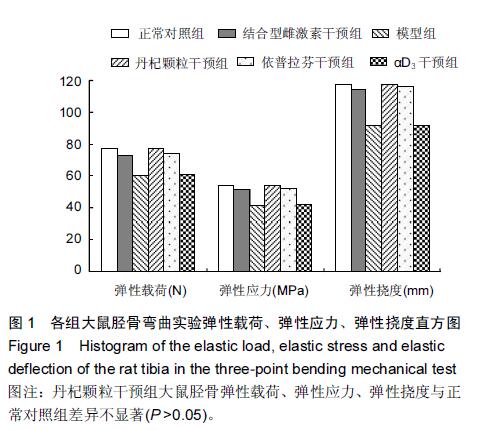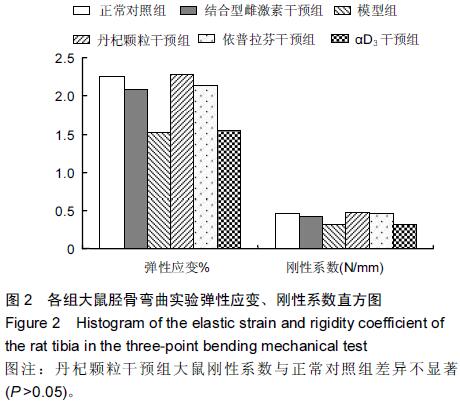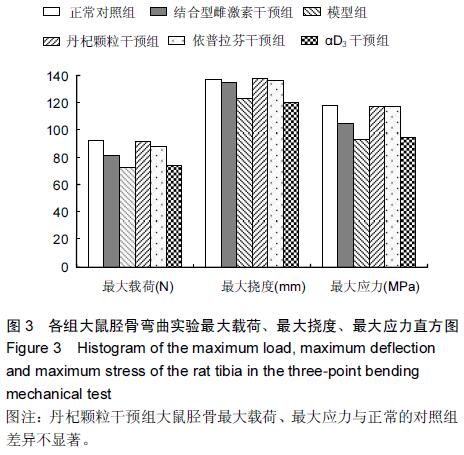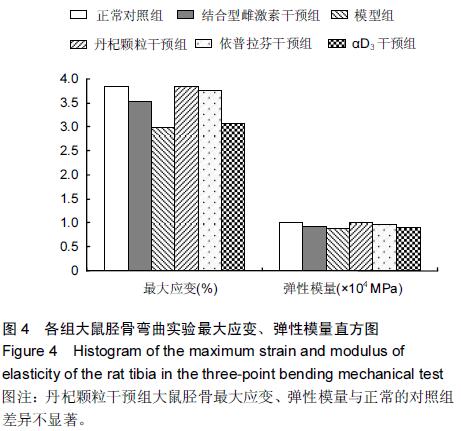中国组织工程研究 ›› 2015, Vol. 19 ›› Issue (46): 7440-7444.doi: 10.3969/j.issn.2095-4344.2015.46.012
• 组织构建与生物力学 tissue construction and biomechanics • 上一篇 下一篇
4种药物干预治疗骨质疏松模型大鼠骨三点弯曲力学特性的对比分析
杨 琦1,彭传刚2,王 野1,王 强3
- 1吉林大学中日联谊医院妇产科,吉林省长春市 130000;吉林大学第二医院,2骨科,3妇产科,吉林省长春市 130026
Three-point bending mechanical properties of the bone in a rat model of osteoporosis after treatment with four kinds of drugs
Yang Qi1, Peng Chuan-gang2, Wang Ye1, Wang Qiang3
- 1Department of Obstetrics and Gynecology China-Japan Union Hospital of Jilin University, Changchun 130000, Jilin Province, China; 2Department of Orthopedics, Second Hospital of Jilin University, Changchun 130026, Jilin Province, China; 3Department of Obstetrics and Gynecology, Second Hospital of Jilin University, Changchun 130026, Jilin Province, China
摘要:
背景:力学性能指标是评价药物治疗骨质疏松动物模型效果的重要方法,以3点弯曲力学性能指标评价多种药物治疗老龄雌性骨质疏松模型动物的效果鲜有报道。 目的:以大鼠骨3点弯曲力学性能指标评价骨质疏松模型大鼠经丹杞颗粒、结合性雌激素、依普拉芬及αD3干预的效果。 方法:Wistar雌性大鼠48只分为6组,除正常组外,采用以去双侧卵巢的方法复制老龄骨质疏松大鼠模型。丹杞颗粒干预组每日给服丹杞颗粒0.9 g/kg,普拉芬干预组每日给服依普拉芬1 mg/kg,αD3干预组每日给服αD3 0.1 mg/kg,结合型雌激素干预组每日给服结合型雌激素0.3 mg/kg。以电子万能实验机对各组大鼠左、右侧胫骨进行3点弯曲力学性能测试。 结果与结论:丹杞颗粒、依普拉芬、结合型雌激素干预组胫骨最大载荷、最大应力、最大弯矩、最大应力及弹性模量大于模型组(P < 0.05);αD3干预组最大载荷、最大应力、最大应变、弹性模量与模型组差异无显著性意义(P > 0.05);丹杞颗粒干预组胫骨最大载荷、最大应力、最大应变与正常对照组比较差异无显著性意义(P > 0.05)。丹杞颗粒干预组、结合型雌激素干预组、依普拉芬干预组弯曲力学性能恢复较好,以丹杞颗粒干预组效果最好,αD3干预治疗组弯曲力学性能指标无明显恢复。结果说明以丹杞颗粒干预骨质疏松模型大鼠胫骨3点弯曲力学性能恢复效果最好。 中国组织工程研究杂志出版内容重点:组织构建;骨细胞;软骨细胞;细胞培养;成纤维细胞;血管内皮细胞;骨质疏松;组织工程





